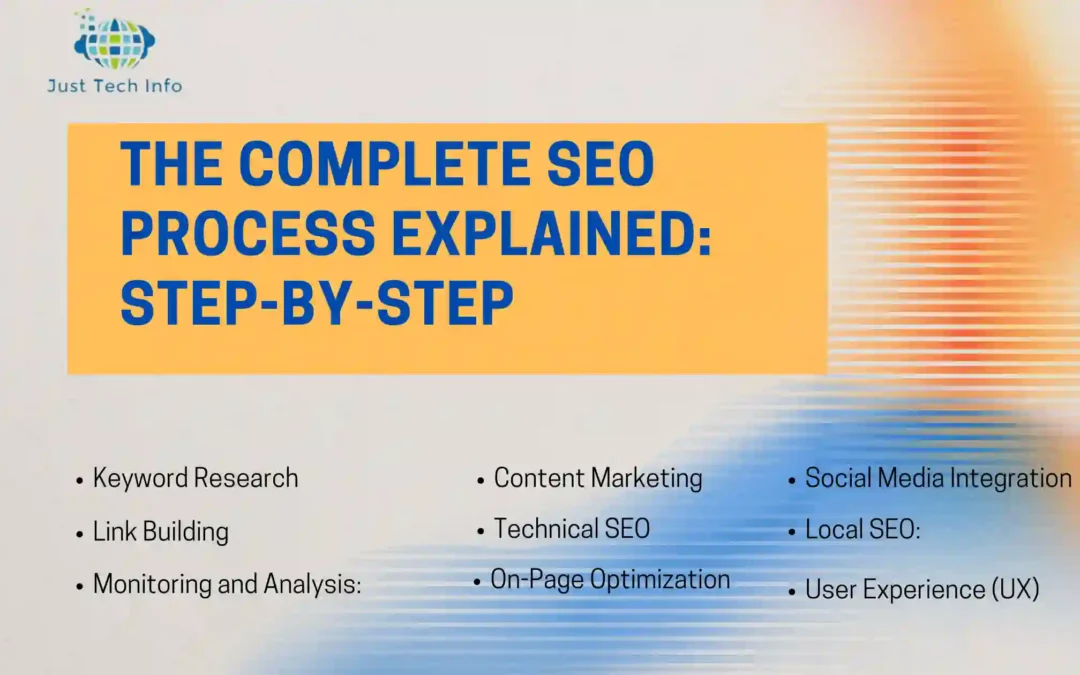Introduction:
Search Engine Optimization (SEO) is a critical digital marketing strategy that helps websites improve their visibility and ranking on search engine results pages (SERPs). By optimizing their online presence, businesses can attract more organic traffic, increase brand awareness, and boost conversions.
Table of Contents
In this article, we’ll take you through the complete SEO process, step-by-step, to help you understand and implement effective SEO techniques for your website.
1. Keyword Research: The Foundation of SEO
The SEO journey kicks off with thorough keyword research It serves as the compass for all of your optimization and content production activities. Utilize tools like Google Keyword Planner to identify relevant keywords based on search volume, competition, and relevance to your content. These keywords will be the backbone of your SEO strategy.
2. On-Page Optimization: Crafting SEO-Friendly Pages
Once armed with your keywords, it’s time to optimize individual pages. Create compelling title tags that not only capture the essence of your content but also include your primary keyword. Craft meta descriptions that entice users to click while providing a concise summary of your content. Develop SEO-friendly URLs that are both user-friendly and contain your target keywords. Employ header tags (H1, H2, etc.) to structure your content logically and naturally incorporate keywords.
Don’t forget about image optimization. Ensure images have descriptive file names and alt text, aiding search engines in understanding your visual content. Mobile responsiveness is non-negotiable in today’s digital landscape, as Google heavily favors mobile-friendly websites. Additionally, optimize page loading speed through techniques like image compression and browser caching.
3. Content is King: Quality and Relevance Matter
Content lies at the heart of SEO. Craft high-quality, valuable content that addresses user needs. Google rewards content that provides genuine value to its users. Naturally integrate your target keywords throughout the text, ensuring a natural flow. Stay away from overloading your content with keywords, as this can hurt your SEO efforts.. Focus on engaging language, proper formatting, and a structure that enhances readability.
Regularly update your content to keep it relevant and authoritative. Google tends to favor fresh, up-to-date content, so staying on top of industry trends and updates is crucial.
4. Link Building: The Web’s Networking System
Link building is the networking system of the web. Develop a robust link profile by incorporating both internal and external links strategically. Internal links connect various pages within your website, aiding navigation and establishing content hierarchy. External links to authoritative sites validate your content in the eyes of search engines. Focus on quality over quantity, emphasizing relevance and credibility in your link-building strategy.
5. Technical SEO: Guaranteeing a Vibrant User Experience
Technical SEO focuses on optimizing the technical elements of your website to ensure a seamless user experience. Prioritize mobile optimization, as Google considers mobile-friendliness a critical ranking factor. Improve page loading speed by implementing techniques like image compression, browser caching, and code optimization. Implement schema markup to enhance the way search engines understand and display your content in search results.
6. Monitoring and Analysis: Data-Driven Decision Making
Monitoring and analysis are the bedrock of effective SEO, guiding data-driven decision-making. Utilizing analytics tools, businesses track key metrics such as organic traffic, bounce rates, and keyword rankings. This constant scrutiny provides insights into user behavior and performance, enabling strategic adjustments. By interpreting data, businesses refine content, optimize user experience, and adapt strategies to evolving algorithms. In the dynamic landscape of SEO, staying ahead relies on the power of real-time data analysis to make informed decisions and foster continuous improvement.
7. Local SEO: Navigating the Local Landscape
Local SEO is crucial for companies who want to reach customers in their community. Activate and enhance your listing on Google My Business. Make sure all online platforms display the same NAP (Name, Address, Phone Number) information. Encourage positive reviews, as they not only contribute to local search rankings but also build trust among potential customers.
8. Social Media Integration: Amplifying Reach

Integrate social media into your SEO strategy. To improve visibility and traffic, share your material on a variety of platforms. Social signals, such as likes and shares, can influence search rankings. Moreover, social media provides an excellent platform for engaging with your audience, building brand authority, and fostering a community around your brand.
9. User Experience (UX): Enhancing Satisfaction and Retention
A positive user experience is pivotal for retaining visitors and encouraging them to explore further. Improve the site’s navigation for quick access to content. Create clear calls-to-action and intuitive forms. Ensure a visually appealing design that is consistent across devices. Mobile responsiveness is not only for SEO; it directly impacts user satisfaction and, consequently, your bottom line.
10. Continuous Learning and Adaptation: Staying Ahead
SEO is a dynamic field. Search engine algorithms evolve regularly, and staying ahead requires continuous learning. Stay informed by following reputable industry blogs, participating in forums, and keeping up with official search engine guidelines. Attend conferences and webinars to pick the brains of professionals. Adapt your strategy based on data, emerging trends, and algorithm changes.
Conclusion:
Mastering the complete SEO process is an ongoing journey that encompasses various elements, from meticulous keyword research to technical optimizations, content creation, link building, and staying attuned to the ever-changing digital landscape. By understanding and implementing each step, businesses and individuals can navigate the complexities of SEO and unlock the full potential of their online presence. Continuous learning and adaptation are the keys to staying ahead in this dynamic and rewarding field.
Read also ” A Comprehensive Guide to the SEO Process and Guest Post Services “






